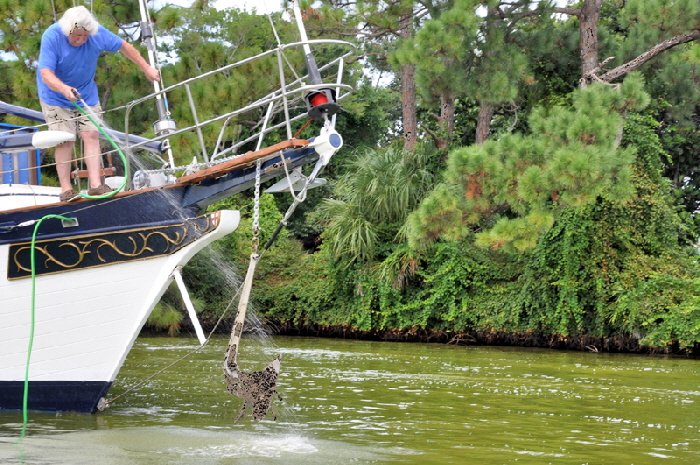Boat owners who regularly anchor in rivers and estuaries will have experienced the horrible situation where their chain/rope and anchor comes up caked in mud and sludge. If they don't have some sort of anchor wash system the smelly stuff makes a big mess on the deck. If you anchor frequently anywhere in the murky waters of Florida's Intracoastal Waterway, (ICW), you would consider an anchor wash absolutely essential!
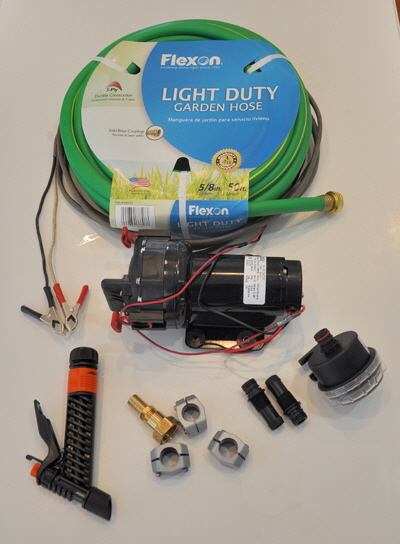 The ICW runs all the way up the Eastern Seaboard of the United States and is a playground for boats of every shape and size, but they all have one thing in common, they all have anchors - well most of them anyway. The ICW is well protected from the Atlantic Ocean by a string of sometimes quite large barrier islands, many with complete towns on them, so for the most part it is non-tidal and the bottom is usually sedentary thick black mud. Upon weighing a deeply bedded anchor half the bottom usually comes up as well, glued to the chain and anchor in the form of a smelly oozing sludge over a layer of hard clay.
The ICW runs all the way up the Eastern Seaboard of the United States and is a playground for boats of every shape and size, but they all have one thing in common, they all have anchors - well most of them anyway. The ICW is well protected from the Atlantic Ocean by a string of sometimes quite large barrier islands, many with complete towns on them, so for the most part it is non-tidal and the bottom is usually sedentary thick black mud. Upon weighing a deeply bedded anchor half the bottom usually comes up as well, glued to the chain and anchor in the form of a smelly oozing sludge over a layer of hard clay.
Even when wet this concrete-like substance is very difficult to clean off an anchor, and if left to dry is practically impossible to remove from chain and often cements the links together. I have seen people trying to poke it off their anchor with a boat hook, or dipping a deck-brush in the water then valiantly attempting to wash the crud off their chain and fore-deck. Britannia has a 5’ foot long bowsprit that both her anchors stow beneath so it is impossible to clean them by hand. I used to pile the dirty chain on deck, then wash it with buckets of water before stowing it. To clean the anchor I would dangle it in the bow wake as we motored away, but that's not advisable if you have only a short bow roller because the anchor will bump against the bow.
All these shenanigans rather took the pleasure out of getting under way, or rather it used to, until I built myself a simple deck-wash system. A powerful deck-wash is highly effective for cleaning a dirty anchor and rode, ensuring it passes into the chain locker in a reasonably unsoiled condition.
You can buy complete deck-wash kits from marine stores and the web. They cost anything from about $200 to $500 depending on the pump pressure and whatever ancillary equipment they include, like hoses, a nozzle, a filter, pipe fittings, etc. They are primarily meant to be mounted below deck, with pipes from a seacock or other seawater source to the pump, then to a deck outlet fitting normally near the bow, to which is attached a water hose and nozzle. These kits don't usually include connecting pipework, or electrical wiring, that adds to the cost of installation.
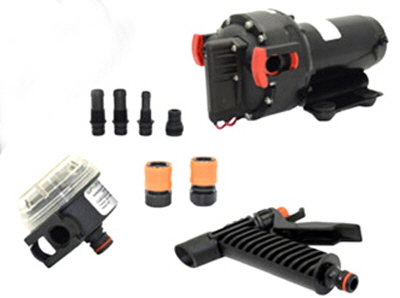 Providing your hose is long enough, a fixed system will also double as an actual deck wash—but that is all it will be. A fixed system cannot be used to pump rainwater out of a dinghy; as an additional bilge pump; or to wash a bilge; or any other job for which a powerful water jet would be useful. Furthermore, they can only pump whatever the system is connected to, usually seawater. In other words a fixed system is not very versatile, with few other uses. The portable deck wash I built can be used for all these functions, and anything else you need to pump water on or off, or out of anything, not just your boat or dinghy. I use mine to empty an ornamental fountain in my garden, that I could never completely empty with a small bailer.
Providing your hose is long enough, a fixed system will also double as an actual deck wash—but that is all it will be. A fixed system cannot be used to pump rainwater out of a dinghy; as an additional bilge pump; or to wash a bilge; or any other job for which a powerful water jet would be useful. Furthermore, they can only pump whatever the system is connected to, usually seawater. In other words a fixed system is not very versatile, with few other uses. The portable deck wash I built can be used for all these functions, and anything else you need to pump water on or off, or out of anything, not just your boat or dinghy. I use mine to empty an ornamental fountain in my garden, that I could never completely empty with a small bailer.
The equipment and assembly is also simplicity itself, consisting only of a high pressure pump with built-in filter, two lengths of regular garden hose, and a hand nozzle. Operation is equally simple. The inlet pipe is just hung anywhere over the side into the water, or a bucket of fresh water, and the pump sucks water up shooting it through the hand nozzle.
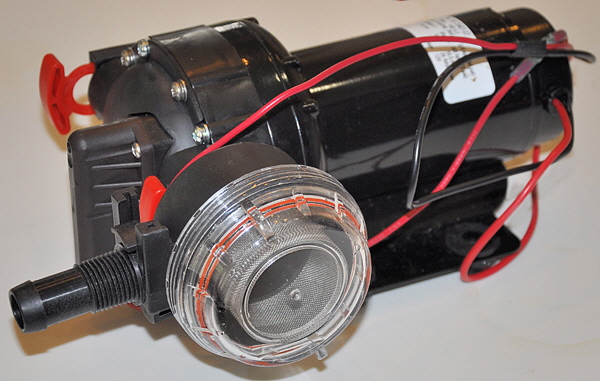 The main item of course is the pump, and there are many on the market to suit different budgets and pressure needs. The only common requirement is: the pump should be self-activating, (also called an on-demand pump), that is, it starts and stops as the hand nozzle is opened and closed and pressure changes in the line. This makes the operation semi-automatic and saves the need for an on-off switch. The pump must also be self-priming with adequate lifting capacity from below the waterline, because if it is not powerful enough to suck water up it obviously won't work. Diaphragm pumps are better than impeller pumps since they are able to run dry, enabling the lines to be pumped empty after use for stowage. Also, unlike an impeller pump, a diaphragm pump has no “kick” as it starts up, that means it won't jump over the side or roll off wherever you place it. On-demand deck-wash pumps are similar to those used for pressurized fresh water systems, for sink faucets and showers on boats.
The main item of course is the pump, and there are many on the market to suit different budgets and pressure needs. The only common requirement is: the pump should be self-activating, (also called an on-demand pump), that is, it starts and stops as the hand nozzle is opened and closed and pressure changes in the line. This makes the operation semi-automatic and saves the need for an on-off switch. The pump must also be self-priming with adequate lifting capacity from below the waterline, because if it is not powerful enough to suck water up it obviously won't work. Diaphragm pumps are better than impeller pumps since they are able to run dry, enabling the lines to be pumped empty after use for stowage. Also, unlike an impeller pump, a diaphragm pump has no “kick” as it starts up, that means it won't jump over the side or roll off wherever you place it. On-demand deck-wash pumps are similar to those used for pressurized fresh water systems, for sink faucets and showers on boats.
After looking at many pump specifications, I decided on the Aqua-Jet WD 5.2 wash-down pump from the Johnson Pumps Company. This is one of the more powerful pumps with a 70 psi pressure, (about the same as a house), and easily sucks water up my boat's 5’ foot freeboard. The pump has a detachable easy to clean filter that saves having to buy and fit a separate one in the line. The filter also swivels, allowing the outlet hose to point forward or back, making it easier to use. Included with the pump kit is a hand nozzle that can also be locked in the open position. The nozzle fits on the hose with a push fitting, so you don't have to unscrew anything when you need to remove it for a continuous higher flow, when emptying a dinghy or as a bilge pump. There are four large rubber feet under the baseplate, so this pump can be placed anywhere on deck without fear of it rolling around and damaging anything. The pump comes with fittings for ½” inch and 5/8” inch water hoses and it is best to use the larger size that has some 60% greater volume, to give the maximum jet. The kit is available from most marine suppliers and on the web for about $140.00. (part #10-13407-07 for 12-volts).
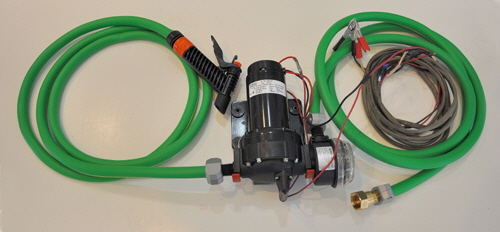 I bought a cheap 15’ foot long, 5/8” inch garden hose, that I cut into a 6’ foot and a 9’ foot length, then attached them both to the pump fitting with clamp type hose fittings. Six feet is long enough to easily hang over the side of my boat, and to keep the end under water I weighted it with two brass fittings from my local hardware store. One has a 5/8” inch barb for the hose and a 3/4” inch NPT thread, on which I screwed another brass nut for added weight.
I bought a cheap 15’ foot long, 5/8” inch garden hose, that I cut into a 6’ foot and a 9’ foot length, then attached them both to the pump fitting with clamp type hose fittings. Six feet is long enough to easily hang over the side of my boat, and to keep the end under water I weighted it with two brass fittings from my local hardware store. One has a 5/8” inch barb for the hose and a 3/4” inch NPT thread, on which I screwed another brass nut for added weight.
For power I found a couple of small crocodile clips, (like used on car jump-leads), in my local auto parts store, that I soldered to a long enough two core wire to reach any of my 12-volt batteries. Do not be tempted to use a cigarette lighter type receptacle you might have in your cockpit. They can get quite warm and shouldn't be used for the continuous current draw of these powerful pumps, that for the Johnson 12-volt unit is 15 amps on start up.
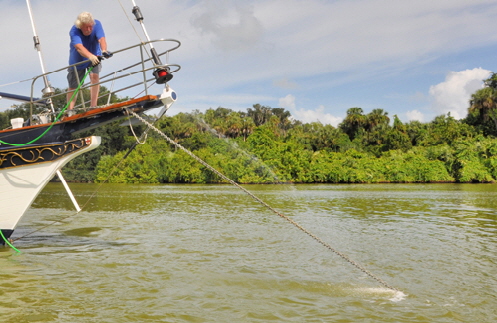 As soon as I clip my pump on to one of my house batteries it begins to hum, but nothing else happens until the hand nozzle is squeezed, when the pump starts sucking water through the pipes and delivers an incredibly powerful 15’ foot long jet that will knock the muck of any anchor and chain. The long reaching jet enables me to hit the chain immediately it comes out of the water, and I can bring the chain up as fast as I like with the windlass. If the hose pipes become clogged with debris the filter is easily unscrewed from the pump and cleaned. The hoses can also be unclipped from the pump by hand without tools with the quick release connectors, to empty the pipes or storage. With the nozzle fitted the pump empties a five gallon bucket in just under three minutes, without the nozzle it takes 1½
As soon as I clip my pump on to one of my house batteries it begins to hum, but nothing else happens until the hand nozzle is squeezed, when the pump starts sucking water through the pipes and delivers an incredibly powerful 15’ foot long jet that will knock the muck of any anchor and chain. The long reaching jet enables me to hit the chain immediately it comes out of the water, and I can bring the chain up as fast as I like with the windlass. If the hose pipes become clogged with debris the filter is easily unscrewed from the pump and cleaned. The hoses can also be unclipped from the pump by hand without tools with the quick release connectors, to empty the pipes or storage. With the nozzle fitted the pump empties a five gallon bucket in just under three minutes, without the nozzle it takes 1½ 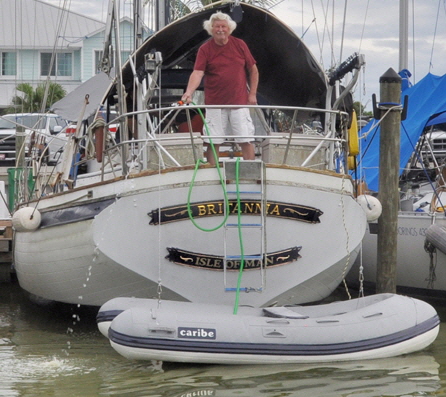 minutes.
minutes.
When I want to wash any part of my deck I just drop the hose over the side, connect the power and fire away. Whenever my dinghy gets full of rain water I simply drop the end of the hose in the boat and pump it dry in just a few minutes from on deck, that beats climbing into the waterlogged dinghy with a hand-bailer any day!
This is a deceptively simple setup that works amazingly well. It is very versatile for many other purposes, yet cheaper than a kit with a comparable power pump. That's something of a rarity in the marine equipment business nowadays, don't you think?
